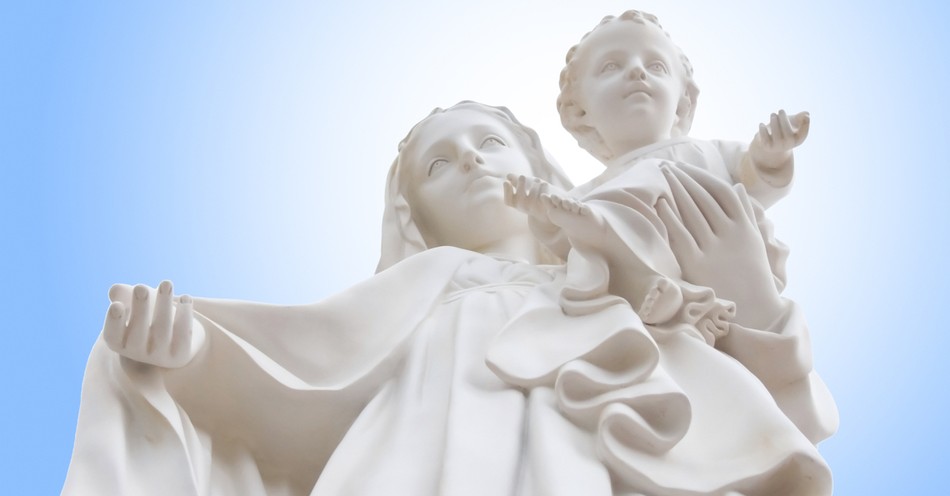Regardless of religious background, most of us have heard of the immaculate conception. However, many do not understand what this phrase means and have misunderstood it for referring to the virgin birth of Jesus.
People all across our nation, whether Christian or not, know that Christmas Day is the celebration of Jesus’ birth. Music describing the event is played in malls, people put nativity scenes under their Christmas tree and on their lawns. Even the well-known Peanuts gang proclaims the true meaning of Christmas in the movie a Charlie Brown Christmas. The virgin birth is rejoiced in by angels and humans. Jesus, the newborn King is the only person to ever walk the earth who deserves glory. He came to bring peace on earth and mercy to sinners like you and me. Ultimately, the virgin birth is the moment in time that began reconciliation between God and sinners.
So if Christmas is the celebration of the virgin birth, then what is the immaculate conception? Is there a difference? And why does the virgin birth matter? Should Christians hold one belief more closely than the other? The answer is a resounding yes: Christians should hold to one belief, the virgin birth. Let’s dive into what the difference is between the virgin birth and the immaculate conception by first asking…
What Is the Immaculate Conception?
The immaculate conception is the belief that Mary was conceived without sin. The Roman Catholic Church teaches that God’s grace touched her during her conception and granted her supernatural redemption. Because of this immaculate conception, the Catholic doctrine teaches that she remained sinless, or in perfect relationship with God throughout her life. Pope Pius IX first declared the doctrine of the immaculate conception infallible in 1854, where he stated:
“We declare, pronounce and define that the doctrine which holds that the Blessed Virgin Mary, at the first instant of her conception, by a singular privilege and grace of the Omnipotent God, in virtue of the merits of Jesus Christ, the Saviour of mankind, was preserved immaculate from all stain of original sin, has been revealed by God, and therefore should firmly and constantly be believed by all the faithful.” -Pope Pius IX, Ineffabilis Deus, 1854
A good distinguishing factor between the immaculate conception and the virgin birth is the traditional date of celebration. The virgin birth is celebrated on December 25th or Christmas Day. However, the immaculate conception has its own traditional celebration called The Solemnity of the Immaculate Conception, which is celebrated on December 8th. In many Catholic countries, it is a national holiday celebrated with a traditional feast.

What Is the Virgin Birth according to the Bible?
The account of the virgin birth is found in both the Gospel of Matthew and the Gospel of Luke. Although both accounts make the same claim, the account of the virgin birth found in Luke 1:26-38 provides more context surrounding Mary’s story. We see an angel appear to a young virgin girl who is pledged to be married. The angel tells her:
“You will conceive and give birth to a son, and you are to call him Jesus. He will be great and will be called the Son of the Most High. The Lord God will give him the throne of his father David, and he will reign over Jacob’s descendants forever; his kingdom will never end.”
How will this be,” Mary asked the angel, “since I am a virgin?”
The angel answered, “The Holy Spirit will come on you, and the power of the Most High will overshadow you. So the holy one to be born will be called the Son of God.”
In Matthew, we see an angel appear to Joseph, Mary’s fiancé. The angel appears to him with the same news, that “what is conceived in her is from the Holy Spirit” (Matthew 1:20). Joseph was faithful to this news and “did what the angel of the Lord had commanded him and took Mary home as his wife. But he did not consummate their marriage until she gave birth to a son. And he gave him the name Jesus” (Matthew 1:24-25).
As the story goes on, an engaged Mary and Joseph travel to Bethlehem to register in a census decreed by Caesar Augustus. “While they were there, the time came for the baby to be born, and she gave birth to her firstborn, a son” (Luke 2:1-7). It is important that not only does the virgin birth include the account of the conception by the Holy Spirit, but that we recognize the legitimate birth of Jesus.
Why Should We Believe in the Virgin Birth?
In order to understand the virgin birth, we must look at three core truths of the Christian faith:
1. The virgin birth is a clear fulfillment of the prophecy in Isaiah that the Messiah would be born of a virgin (Isaiah 7:14, Matthew 1:22-23). This points to the reality that our salvation is not birthed out of our own effort or goodwill, but rather God’s saving grace. God, in His sovereign will, sought to bring Jesus about through the work of the Holy Spirit so that no man could take the glory (Ephesians 2:8).
2. Mary’s conception of Jesus through the Holy Spirit sets Jesus as both fully man, and fully God. Jesus, God of the universe, came down from heaven to earth to take on flesh. Perfectly sinless (2 Corinthians 5:22), He came to live the life we never could, and die the death He didn’t deserve, in order that we might become the righteousness of God. Hebrews 4:14-16 says:
“Therefore, since we have a great high priest who has ascended into heaven, Jesus the Son of God, let us hold firmly to the faith we profess. For we do not have a high priest who is unable to empathize with our weaknesses, but we have one who has been tempted in every way, just as we are—yet he did not sin. Let us then approach God’s throne of grace with confidence, so that we may receive mercy and find grace to help us in our time of need.”
Only a God that is both fully human and fully divine could ever be capable of both empathizing with us and saving us from the ultimate wrath of God. It is a glorious wonder that God sent His son, Jesus Christ to be our mediator. It is in this truth that we can rest in the fact that God is with us - Immanuel.
3. Ultimately, the virgin birth is believed in and celebrated because the long-awaited messiah has finally come - Jesus, the savior of the fallen world was born as a ransom for many (Mark 10:45). In the virgin birth, the King is finally born - the King that every knee shall bow to, and every tongue confess, that Jesus is Lord (Philippians 2:10-11).
What Is the Main Difference between Belief in the Virgin Birth and Belief in the Immaculate Conception?
Belief in the two teachings primarily differs in the reliability of their sources. Belief in the virgin birth is based on scriptural doctrine. You can go back to the book of Genesis, all the way through to Revelation and discover the reality of the God-man being the savior of the whole world. However, belief in the immaculate conception is based primarily on tradition and man’s word. There is no biblical evidence for the immaculate conception of Mary, rather, the Roman Catholic Church seems to declare it based on speculation. We must keep in mind also that the immaculate conception was not even believed to be an infallible doctrine in the Roman Catholic Church until 1854. This in and of itself reinforces a belief of tradition and man’s word over the valuing and upholding of God’s Word. As Christians, we must seek to uphold the value and truth of God’s word, as we will be held accountable for the knowledge we have attained (Luke 12:41-48).
What's Wrong with the Idea of the Immaculate Conception according to the Bible?
The main problem with belief in the immaculate conception surrounds the idea of Mary being conceived without sin. The Bible is very clear that Jesus is the only human who will ever walk the earth without sin. Thomas Schreiner, Professor at Southern Baptist Theological Seminary says it this way:
The notion of the immaculate conception should be rejected. Thomas Aquinas didn’t accept it, and we aren’t surprised since there is no biblical evidence for this idea. Even more problematic is the claim that Mary was sinless. We probably have an indication of her sinfulness in Mark 3:21, where Jesus’s family thinks he is insane (Mark 3:31-35).
Of course, Mary was a godly woman, but she was godly because God’s grace rescued her from her sins based on Christ’s atoning work. The only sinless human being was Jesus Christ (John 8:46; 2 Corinthians 5:21; Hebrews 4:15; 7:26; 1 Peter 2:22; 1 John 3:5). By placing Mary on the same plane as Jesus, the matchless glory of Christ is diminished. His uniqueness is compromised, even if it is claimed that Mary’s sinlessness is rooted in Jesus’s work.”
The Virgin Birth Is the Declaration of God and Sinners being Reconciled
As we consider the virgin birth and all that it encompasses, I believe the main theme we see is a declaration of God and sinners being reconciled. It points to God’s rich mercy, sovereign grace, and weighty glory. The lyrics in Hark the Herald Angels Sing speaks to this declaration. Consider and rejoice with me, as the tune plays in your mind, of all that this doctrine means:
“Hark! the herald angels sing, ‘Glory to the new-born King! Peace on earth, and mercy mild, God and sinners reconciled.’
Joyful, all ye nations, rise, Join the triumph of the skies; With th' angelic host proclaim, ‘Christ is born in Bethlehem.’
Hark! the herald angels sing, ‘Glory to the new-born King! Christ, by highest heaven adored: Christ, the everlasting Lord;’
Late in time behold him come, Offspring of the favoured one. Veiled in flesh, the Godhead see; Hail, th' incarnate Deity:
Pleased, as man, with men to dwell, Jesus, our Emmanuel! Hark! the herald angels sing, ‘Glory to the new-born King!’
Hail! the heaven-born Prince of peace! Hail! the Son of Righteousness! Light and life to all he brings, Risen with healing in his wings
Mild he lays his glory by, Born that man no more may die: Born to raise the son of earth, Born to give them second birth. Hark! the herald angels sing, ‘Glory to the new-born King!’"
References:
BBC
Desiringgod.org
Photo credit: ©GettyImages/ollirg
Stephanie Englehart is a Seattle native, church planter’s wife, mama, and lover of all things coffee, the great outdoors, and fine (easy to make) food. Stephanie is passionate about allowing God to use her honest thoughts and confessions to bring gospel application to life. You can read more of what she writes on the Ever Sing blog at stephaniemenglehart.com or follow her on Instagram: @stephaniemenglehart.




